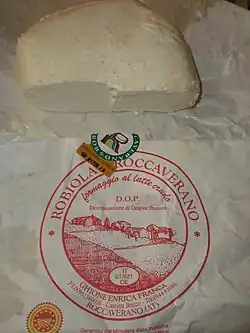Roccaverano goat
| Conservation status | FAO (2007): not at risk[1] |
|---|---|
| Country of origin | Italy |
| Distribution | Piemonte |
| Standard | MIPAAF |
| Use | milk, also meat[2] |
| Traits | |
| Weight | |
| Height | |
| Coat | variable: white, brown or black |
| Horn status | usually hornless[4] |
| Beard | usually bearded[4] |
| Tassels | present in about 50%[4] |
| |
The Roccaverano is an Italian breed of large domestic goat from the Langhe, in the provinces of Asti and Cuneo, in Piemonte in north-western Italy. It is raised mainly in the Langa Astigiana, mostly within the Comunità montana Langa Astigiana Val Bormida}, and is named for the town and comune of Roccaverano in that area.[2] The origins of the breed are unknown.[2]
The Roccaverano is one of the forty-three autochthonous Italian goat breeds of limited distribution for which a herdbook is kept by the Associazione Nazionale della Pastorizia, the Italian national association of sheep- and goat-breeders.[5][6] At the end of 2013 the registered population was variously reported as 3117[7] and as 2390.[8]
Use

The milk yield of the Roccaverano per lactation of about 240 days is 246±76 litres for primiparous, 378±146 litres for secondiparous, and 397±154 litres for pluriparous, nannies.[6] The milk averages 3.30% fat and 3.05% protein, and is all used to make robiola, either Robiola di Roccaverano, made with a mixture of cow's milk, goat's milk and sheep's milk, which has DOP status; or the pure goat's-milk Robiola di Roccaverano pura caprina.[2]
Kids 30–45 days old and weighing 12–14 kg are slaughtered at Easter time.[3]
References
- ^ Barbara Rischkowsky, Dafydd Pilling (editors) (2007). List of breeds documented in the Global Databank for Animal Genetic Resources, annex to: The State of the World's Animal Genetic Resources for Food and Agriculture. Rome: Commission on Genetic Resources for Food and Agriculture, Food and Agriculture Organization of the United Nations. ISBN 9789251057629. Archived 23 June 2020.
- ^ a b c d Daniele Bigi, Alessio Zanon (2008). Atlante delle razze autoctone: Bovini, equini, ovicaprini, suini allevati in Italia (in Italian). Milan: Edagricole. ISBN 9788850652594. p. 386–87.
- ^ a b c d e Lorenzo Noè, Alessandro Gaviraghi, Andrea D'Angelo, Adriana Bonanno, Adriana Di Trana, Lucia Sepe, Salvatore Claps, Giovanni Annicchiarico, Nicola Bacciu (2005). Le razze caprine d'Italia (in Italian); in: Giuseppe Pulina (2005). L' alimentazione della capra da latte. Bologna: Avenue Media. ISBN 9788886817493. p. 381–435. Archived 5 October 2014.
- ^ a b c Norme tecniche della popolazione caprina "Roccaverano": standard della razza (in Italian). Associazione Nazionale della Pastorizia. Accessed June 2014.
- ^ Strutture Zootecniche (Dec. 2009/712/CE - Allegato 2 - Capitolo 2) (in Italian). Ministero delle Politiche Agricole Alimentari e Forestali. Section I (e). Archived 4 May 2014.
- ^ a b Le razze ovine e caprine in Italia (in Italian). Associazione Nazionale della Pastorizia: Ufficio centrale libri genealogici e registri anagrafici razze ovine e caprine, page 107. Archived 21 September 2013.
- ^ Consistenze Provinciali della Razza 95 Roccaverano Anno 2013 (in Italian). Associazione Nazionale della Pastorizia: Banca dati. Accessed June 2014.
- ^ Breed data sheet: Roccaverano/Italy. Domestic Animal Diversity Information System of the Food and Agriculture Organization of the United Nations. Accessed June 2014.